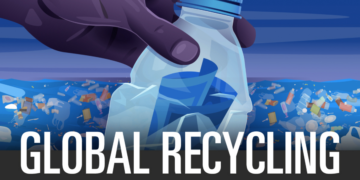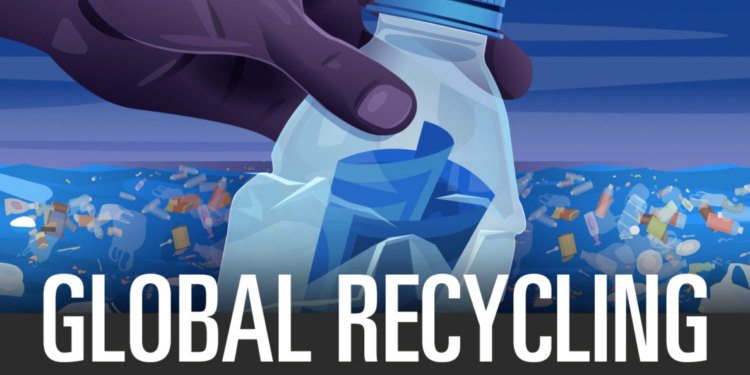Plastic was first introduced to the world in the early 20th century, and while the convenience of plastic made products is clear, we’re starting to see the damaging effect it has on the environment and world systems.
For decades, we as a people, have been advised to “recycle” plastic, to be reused instead of simply throwing it away and adding to the exponentially growing global landfill. However, the previous system of recycling is not as effective as you may think, and since China’s global plastic ban (where the majority of recycled plastic was sent to), recycling is in a broken state.
But it doesn’t have to be.
Shifting Attitudes Towards Foreign Recyclables
For decades, Western countries avoided the environmental costs of consumerism by outsourcing their recycling to the developing world. Since 1992, China imported nearly half of the world’s recyclables and waste, but recent restrictions have brought this tradition to an end.
Timeline
2013:
China’s Operation Green Fence is launched to increase the inspection of imported recyclables.
2017:
China’s National Sword is launched to target foreign recyclable imports and smuggling.
2018:
China implements a ban on the import of 24 types of recyclables, as well as a new contamination standard of 0.5%.
2019:
Several Southeast Asian countries announce future bans on foreign recyclables, and begin sending shipments back to their original countries.
An Industry Under Stress
The world’s reliance on China for waste management was never a sustainable solution. As global population grows, so too does the amount of plastic being produced.
Today, the U.S. and EU produce more plastics per capita than many other areas of the world. Yet, their domestic recycling infrastructures are grossly undeveloped. In 2016, European plastic exports to China peaked at roughly 300,000 tons per month (the equivalent of 33 Eiffel Towers).
Shifting demographics, however, has quickly shrunk China’s appetite for foreign recyclables.
The Rising Middle Class
By 2030, the global middle class is expected to reach 5.3 billion people. This growth will result in higher purchasing power for an additional 2 billion people. In other words, the demand for food, water, and plastic will be pushed even further.
While this rate of growth is alarming, the key consideration is where the growth is set to occur by 2030: 350M in China, 380M in India, 210M in the rest of Asia, and 130M in the rest of the world.
With the majority of growth concentrated in Asia, China realized it no longer has the capacity to serve as the world’s dumping ground.
National Sword Policy
At the beginning of 2018, China’s National Sword policy banned the import of foreign recyclables, and used plastic exports to China plummeted by nearly 96% in a single year.
Following the ban, Southeast Asia became the top destination to export recyclables and other waste. Throughout 2019, however, countries in the region pushed back.
Philippines – Sends 51 containers of mixed waste and plastic back to South Korea.
Malaysia – Announces it will return more than 3000 tons of recyclables and other contaminated waste to the countries it originated from.
Vietnam – Stops issuing licenses for the import of recyclables and waste, and launches investigations into the 6000+ containers clogging its ports.
The End of “Easy” Recycling
With outsourcing off the table a lack of domestic recycling solutions presents an attractive investment opportunity.
Western countries are building out their recycling capabilities, and the global market’s revenues are expected to increase rapidly.
Crucially, capacity isn’t the only challenge that the West faces. The widely adopted single stream recycling system is long overdue for improvements.
With this system, consumers place their recyclables into a single bin. The mixture is then brought to a material recovery facility to be sorted and processed.
Advantages:
- Increased participation rates. The consumer side simplicity of this system has led to higher participation – 66% of Americans said they would not recycle a product if it was not easy to do so.
- Collection efficiency. A single stream system reduces collection costs when compared to a multi-stream system.
Disadvantages:
- Increased contamination. The mixture of plastics, chemicals and food waste make recycling costly. On average 1 in 4 items that arrive at an MRF are too contaminated to be recycled.
- Sorting Inefficiency. MRF’s must sort through many materials at once. Every 1 in 6 bottles and 1 in 3 cans are sorted incorrectly.
Existing recycling systems are also unable to breakdown many complex plastics, leaving a tremendous supply gap.
There is only a 6% supply of recycled plastics, or 2.5 million tons, with the total demand reaching nearly 38 million tons.
This untapped potential has attracted over 60 technology providers in North America to develop a method for breaking down old plastics into usable raw materials. If successful, these technologies could meet an addressable market with potential revenues of $120B in the US and Canada alone.
Europe’s Emergence as a Global Leader
The progress so far looks promising. In the aftermath of National Sword, the EU passed ambitious legislation to promote recycling industry investment.
EU Plastics Strategy:
All plastic packaging to be recyclable or reusable by 2030. Industry growth could create up to 200,000 new jobs.
Single Use Plastics Directive:
Member states must achieve a 90% collection rate for plastic bottles by 2029. Plastic bottles must incorporate at least 30% recycled content by 2030.
The European market has already begun to scale up. With nearly 29.1M tons collected in 2018, 32% was recycled, with the majority occurring inside the EU.
China’s ban on foreign plastics has exposed the frailty of a single-supplier global recycling model. While the rest of the world scrambles to establish domestic solutions, this undeveloped sector represents a compelling growth opportunity for investors.
Data sourced from Visual Capitalist.







































